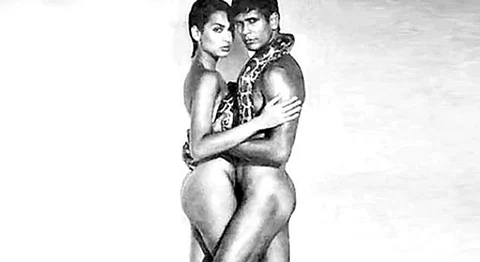
- HOMEGROWN WORLD
- #HGCREATORS
- #HGEXPLORE
- #HGVOICES
- #HGSHOP
- CAREERS
- ABOUT US
- CONTACT US

A score and four years ago - yes, 1995 was precisely that long ago - Tuffs shoes published an ad in a leading Indian daily featuring a nude Madhu Sapre and Milind Soman, wearing nothing but shoes and a python wrapped delicately around them. Photographed by none other than the late Prabuddha Dasgupta, a photographer William Dalrymple posthumously credited as the man who “invented glamour” for the India of the 1990s. Think Genesis 101 and multiply that with the kind of Biblical references that titillate Robb Zombie while he sleeps.
As is the now-expected flow of events, following its release, protests sparked and there was a general fervour of disdain instigated by the Shiv Sena against the two models, the agency and the brand for creating said ad. Moral police allegedly handed out Saris to Sapre’s father outside their home shortly after too. “When Soman and Sapre admitted on 27 July that they had posed in the nude for the Tuffs shoes campaign, the moral mafia descended on them. They were charged with violating the Indecent Representation of Women Act, 1986, and subsequently under Section 292(A) of the Indian Penal Code” stated an India Times report. The case was in dispute for 14 years, with the models finally finding themselves acquitted in 2009.
In the interest of retrospect, however, it’s interesting to imagine what might have happened had the same ad been released today. Today being the age of media trials, social media trolls and hyper-nationalist morality. Perhaps most importantly, the fact that the controversy the ad went through was dealt with via a conclusive legal proceeding that reached an actual verdict after many years is proof enough of how the times have changed. Chances are verdicts would be passed far quicker today, and by a body much larger than the courts of the land, by both social media and the actual media. Both of which would continue to feed off of each other before any real conclusion could be reached.
One wonders though, what would the internet have to say? As sure as the sun does shine, the omnipresent protectors of all things moral would have been out in the thousands on every post, article or meme that would have been generated out of the ad. Animal welfare activists would stand vehemently against the use of a python and at least a few politicians would try to ride the wave threatening to blacken their faces or trash the offices of the agency that commissioned the ad in the first place. For a little while, perhaps, the models themselves might have laid low on their social accounts, while more articles and comments, still, came out questioning every aspect of Sapre’s character, choices, and life. Because let’s be honest...Soman would have sailed right through without much more than a few battle scars. Regardless, there’s no denying that these two would have been bigger household names than they could ever have imagined—trending in every corner of every platform—if only for a couple of days. Is there a fame greater, or more transient, than that? Legalities notwithstanding, one thing is certain—this verdict would have been crowdsourced via public opinion, not any court’s expertise.
This advertisement was, and still is, a landmark moment for Indian advertising, a milestone in our advertising culture. The kind of engagement it had at that time would significantly change in our age of digitisation and social media trials, both in terms of volume and impact. This is not a revelation but in an era of heightened censorship and moral policing, we felt it was interesting to examine all the similarities and dissimilarities against different timelines.
But with great volume comes great diversity in opinion. It seems just as likely that for all the inevitable haters, there would certainly have been an equal and opposite reaction. A whole host of people who would have supported this ad as an expression of creativity, freedom, even art. With Tanishq’s ad indicating the second marriage of a woman, and with Fast Track’s “In the Closet” ad, Indian advertising has come a long way. There’s an audience for it, yet, we still seem to shy away from the body in its natural form, bodies in every size and colour, bodies with nothing to hide - real bodies.
It is this, fundamentally, that remains a question ever unanswered. Is the show of the body in the way evolution designed it to be really an act of obscenity? Or have we come further than where we were in 1995, moving forward on a path towards acceptance, away from the cloud of puritanism that India is so heavily weighed down by? We can only hope that advertisements of this nature will be tagged as progressive in the time to come, rather than the blinking red tag of ‘controversial’ that it currently fits under.
